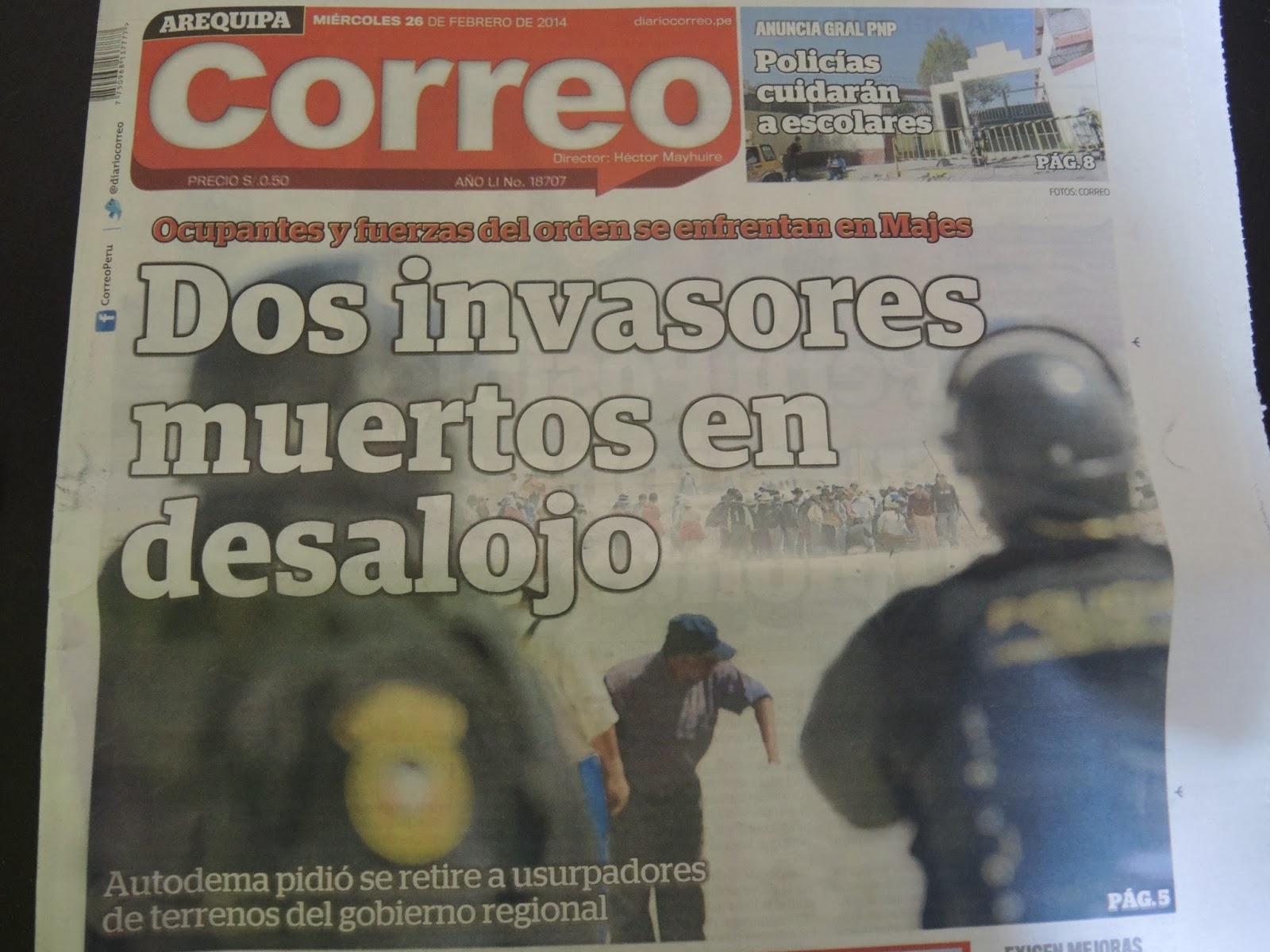Yesterday, two persons died and six were injured in a
confrontation between land invaders and police in Majes district, Arequipa
region. Land invasions, property conflicts, plot trafficking, and violent
encounters have been escalating since Majes become an independent district 14
years ago, but this is first time people have been killed in a confrontation
between land invaders and the police during an eviction.
A group of people invaded a piece of land owned by the Autodema (a regional
state agency in charge of the Majes irrigation project) in December, and
yesterday afternoon, the police showed up to evict them. They destroyed the
straw houses and shacks and were met with resistance by the invaders who were
armed with stones and guns. The result was two dead and six injured.
First page of today’s local newspaper Correo: “Two
invaders dead in eviction”.
During the last weeks, I have been trying to figure out how
property relations and land transactions take place here, but it’s all quite
confusing. The state – through Autodema – reserved a big area for the
Majes-Siguas irrigation project in the 1970s, and in 2004 they transferred 6200
hectares to the Municipal District of Majes for urban development. But they had
already given rights to urban plots to approx. 4000 families; rights which
these families now have to formalize through the Municipality and Public registers. The municipal Formalization office currently has 20.000 cases. They try to make
the process of urban development as orderly as possible, and their maps look
very orderly indeed.
But I have started to realize, that it’s a complete chaos out there: a no-mans land where nobody has control and where mafia, gunmen and corrupt politicians rule… The director of the Formalization Office at the Municipality (a female lawyer who explained the legal norms and rules to me) told me that she has received death threats and has met armed thugs when she went to give someone an evacuation order.
But I have started to realize, that it’s a complete chaos out there: a no-mans land where nobody has control and where mafia, gunmen and corrupt politicians rule… The director of the Formalization Office at the Municipality (a female lawyer who explained the legal norms and rules to me) told me that she has received death threats and has met armed thugs when she went to give someone an evacuation order.
As everywhere in Peru, there is undoubtedly a lot of
corruption involved. The district’s first mayor was actually in jail for three
years because of “irregularities”. To complicate the situation further, a family showed
up some years ago with papers saying that the lands that supposedly belonged to
Autodema and the Majes project, really was their private property, and they
made a lawsuit against Autodema and the Municipality.
Simultaneously, there are land traffickers and mafias
operating on the same lands. Sadly, most of the victims are migrants from the
highlands or relatively poor people who have been fooled into buying a piece of
land from someone who is not the legal owner. The false owner might succeed in
selling to not only one, but two or three persons who now think that they are
the new owners. These situations might result in ugly confrontations.
Another problem is the invasion of others’ land. If
you have bought a plot legally, but does not live there, others might just take
it and build a house there. And if you go to kick them out, you risk to be
beaten up. It’s your responsibility to look out for your land; owners are advised
to build at least a shack and plant some trees to show an intention to live
there, and to check on the place regularly. If someone invades, you should
report it to the police immediately. However, if you don’t check on your plot
for three years, you risk losing it to an invader.
The sad part is that there are families who really
need a place to live, people who have moved from a poor rural community, where
making a livelihood from small scale farming is becoming more difficult every
day. But the ones gaining money on the need for land, are traffickers who make
it a “profession” to invade and to resell the land. Some even invade the land
that others have invaded before.
On Sunday, I was invited to a meeting in a desert
area, where a group of 200 persons bought land in 2004 and formed an
association. Their plan is to build houses and have small farms, but they
haven’t done anything yet, because there is a legal dispute over the land
between the family Vásquez Díaz, who sold the land to the association, and the
state. Meanwhile, other people have invaded the territory and made started to
construct buildings. These persons are armed, and when we arrived to the
meeting place, we met a police office and an attorney, and we learned that
there had been a shooting episode earlier that day, and a man was hurt. This is
not the first time; in the last couple of weeks, thugs have beaten up a man and
there have been shooting several times. When the police go there to check, however,
they hide their guns and the police don’t find anything. But people are ready
to defend their territory and start building their own houses to strengthen
their claim to the land.
The armed invaders seen from a distance. I don’t know
them, but I suspect they are crazy.






